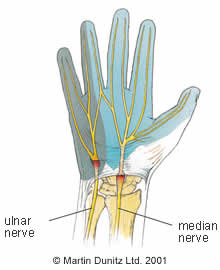| Common Signs & Symptoms | |||||
| Pain | Swelling | Stiffness | Weakness | Instability | Locking |
Carpal Tunnel Syndrome Injury Explained
Carpal Tunnel Syndrome is a common cause of wrist and hand pain. Carpal Tunnel Syndrome can also be characterised by pins and needles’ in the hand. The Carpal Tunnel refers to a gap in the carpal (wrist) bones through which muscles, blood vessels and nerves pass on their way to the hand from the forearm. This anatomical space is covered by a retinaculum which is very limited to start with and the problem of Carpal Tunnel Syndrome arises when there is swelling within this small space.

In normal circumstances the pressure within the Carpal Tunnel is less than 10mmHg, but in patients with Carpal Tunnel Syndrome this pressure rises to above 30mmHg due to swelling. During wrist movements in those with Carpal Tunnel Syndrome the pressure can rise to over 90mmHg.
The exact cause of swelling within the Carpal Tunnel is different in each individual although it is often associated with other medical conditions that the person may have. In various ways these medical conditions increase the pressure within the Carpal Tunnel. The use of repetitive activities during work and sports and vibrating tools and machinery is also thought to contribute to Carpal Tunnel Syndrome. Repetitive wrist flexion movements such as typing, gripping, racquet sports or driving can exacerbate Carpal Tunnel Syndrome. The increased size (hypertrophy) of the wrist flexor tendons may reduce the space available within the retinaculum, compressing neighbouring nerves and blood vessels. As the space within the Carpal Tunnel is reduced, the Median nerve that supplies the hand, can be compromised.
Studies have suggested that Carpal Tunnel Syndrome is more common in women than in men, and is has been associated with conditions such as diabetes, arthritis, hypothyroidism and following wrist fractures. However in most cases of Carpal Tunnel Syndrome it may not be possible to identify a cause.
Carpal Tunnel Syndrome Signs & Symptoms
Compression of the Median Nerve causes altered sensation in the wrist and the fingers nearest the thumb, as well as in the thumb itself. Commonly, there is burning, tingling and numbness in addition to pain in the wrist, hand or thumb. In severe cases the muscle bulk at the base of the thumb can begin to waste, because the nerve supply to the muscles becomes compromised. This leads to muscle weakness and a decreased ability to pinch grip’.
Carpal Tunnel Syndrome Treatment
What you can do
| Consult a sports injury expert | |
| Apply cold therapy to reduce swelling and pain | |
| Wear a wrist brace for protection | |
| Regain dexterity with therapeutic putty | |
| Relieve wrist stiffness with hand therapy balls | |
| Improve hand & grip strength with resistance exercises |
Rest from activities such as typing, hammering or gripping a racquet can be helpful. The use of a Wrist Support or a Wrist Splint can reduce wrist pressure and pain by limiting excessive wrist movement. Researchers in The Netherlands found that 90% of Carpal Tunnel Syndrome patients who used a wrist brace had complete relief of symptoms. The wrist brace should be kept on 24 hours a day and may be required for between 2 and 6 weeks. The wrist brace works because it prevents the movement that causes an increase in Carpal Tunnel Syndrome pressure.
Where there is severe pain, Non Steroidal Anti Inflammatory Drugs (NSAIDs) prescribed by a doctor can be effective for the relief of symptoms by reducing swelling. This can be aided by the application of Ice Packs (never apply ice directly to the skin), although (further) compression will clearly not be helpful.
In more long-standing cases, if the vicious cycle of movement and inflammation can not be broken conservatively, corticosteroid injections may be more effective. These are aimed at decreasing inflammation and swelling within the Carpal Tunnel and, in severe cases, several may be required before symptoms are resolved.
If this approach fails to solve the problem, then surgery may be required. Conventionally, surgery has been performed using an open technique, with the aim being decompression of the Carpal Tunnel. More recently, an arthroscopic and less invasive technique has been developed.
The major advantage of the arthroscopic technique is that the procedure can be performed under local anaesthetic, meaning that it can be done on an out-patient basis. The arthroscopic technique requires two small incisions – one in the wrist and one in the palm of the hand – and a very small diameter camera is then inserted to allow the surgeon to see the Carpal Tunnel. Following the arthroscopic release, the wrist is usually supported in a Wrist Brace for between 4 and 6 weeks.
Physiotherapy treatment is very important to regain range of wrist motion, rebuild thumb muscle strength and to resolve stiffness. Exercises using hand Therapy Balls and Therapeutic Putty can be very helpful to regain mobility. Grip and thumb Strengthening Devices can also be useful to restore normal hand and thumb strength. If an arthroscopic procedure has been carried out, it is important to reduce the small scar tissue surrounding the incision points, with massage or cross friction techniques. These two small areas, if left untreated may cause the return of symptoms or other complications due to the disruption in muscle fibres.
Carpal Tunnel Syndrome Prevention
Because the exact cause of Carpal Tunnel Syndrome is unknown there is no firm evidence on the prevention of this condition. However, it would seem sensible to avoid repetitive wrist movements during work and sports activities. If you have to use machine tools or work at a computer then you should take regular breaks to prevent the wrist tissues becoming overloaded.


